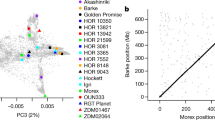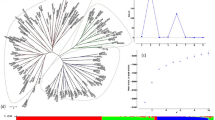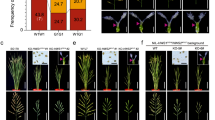Summary
The extent of cross-pollination was estimated quantitatively in 26 populations of wild barley (H. spontaneum) in Israel, using allozyme variation at 22 polymorphic loci. Individual population estimates varied from 0 to 9·6 per cent outcrossing. The overall average was 1·6 per cent, with a 95 per cent confidence range of 0·8-2·7 per cent. The evidence indicated that outcrossing was significantly higher in populations growing in the more mesic (2·1 percent), than in the xeric regions (0·4 per cent). The average frequency of multilocus homozygosity for the 22 loci was 0·963 which was in agreement with the level expected under the observed high rate of self-fertilisation, indicating no heterozygous excess. However, the heterozygotes encountered, displayed a very high degree of multiple heterozygosity which arises from extensive gametic phase (or linkage) disequilibrium. In general, these results do not support the contention that the bulk of the genetic polymorphism found in H. spontaneum in Israel has arisen in recent times by periodic introgression from cultivated barley (H. vulgare L.). Rather they indicate that extensive genetic polymorphisms probably predates the domestication of the crop, and is maintained independently of introgression.
Similar content being viewed by others
Article PDF
References
Allard, R W. 1975. The mating system and microevolution. Genetics, 79s, 115–126.
Allard, R W, Kahler, A L, and Weir, B S. 1972. The effect of selection on esterase allozymes in a barley population. Genetics, 72, 489–503.
Amiran, D H K, Elster, J, Gilead, M, Rosenan, N, Kadmon, K, and Paran, U, (Eds.). 1970. Atlas of Israel. Elsevier, Amsterdam.
Babbel, G R, and Wain, R P. 1977. Genetic structure of Hordeum jubatum. I. Outcrossing rates and heterozygosity levels. Can J Genet Cyt, 19, 143–152.
Bennett, J H, and Binet, F E. 1956. Association between Mendelian factors with mixed selfing and random mating. Heredity, 10, 51–55.
Brown, A H D. 1975. Efficient experimental designs for the estimation of genetic parameters in plant populations. Biometrics, 31, 145–160.
Brown, A H D, Marshall, D R, and Albrecht, L. 1974. The maintenance of alcohol dehydrogenase polymorphism in Bromus mollis L. Aust J Biol Sci, 27, 545–59.
Brown, A H D, Matheson, A C, and Eldridge, K G. 1975. Estimation of the mating system of Eucalyptus obliqua L. Herit using allozyme polymorphisms. Aust J Bot, 23, 931–49.
Brown, A H D, Nevo, E, and Zohary, D. 1977. Association of alleles at esterase loci in wild barley Hordeum spontaneum. Nature, 268, 430–431.
Brown, A H D, Nevo, E, Zohary, D, and Dagan, O. 1978. Genetic variation in natural populations of wild barley (Hordeum spontaneum). In preparation.
Fröst, S, and Holm, G. 1975. Variation of flavonoid patterns in Hordeum spontaneum and H. agriocrithon. Hereditas, 80, 167–172.
Fröst, S, Holm, G, and Asker, S. 1975. Flavonoid patterns and the phylogeny of barley. Hereditas, 79, 133–142.
Hamrick, J L, and Allard, R W. 1972. Microgeographical variation in allozyme frequencies in Avena barbata. Proc Nat Acad Sci USA, 69 (8), 2100–2104.
Harding, J, Mahnen, C B, and Elliot, M H. 1974. Genetics of Lupinus. VII: Outcrossing autofertility, and variability in natural populations of the nanus group. Taxon, 23, (5/6), 729–738.
Harlan, J R. 1965. The possible role of weed races in the evolution of cultivated plants Euphytica, 14, 173–176.
Harlan, J R, and Zohary, D. 1966. Distribution of wild wheats and barley. Science, 153, 1074–1080.
Hvid, S, and Nielsen, G. 1977. Esterase isoenzyme variants in barley. Hereditas, 87, 155–162.
Jain, S K. 1975. Population structure and the effects of breeding system. In Crop Genetic Resources for Today and Tomorrow, IPB2, eds. O. H. Frankel and J. G. Hawkes, 15–36.
Jain, S K. 1977. Genetic diversity of weedy rye populations in California. Crop Sci, 17, 480–482.
Kahler, A L, and Allard, R W. 1970. Genetics of isozyme variants in barley. 1. Esterases. Crop Sci, 10, 444–448.
Kahler, A L, Clegg, M T, and Allard, R W. 1975. Evolutionary changes in the mating system of an experimental population of barley (Hordeum vulgare L.). Proc Mat Acad Sci USA, 72, 943–946.
Marshall, D R, and Allard, R W. 1970. Maintenance of isozyme polymorphisms in natural populations of Avena barbata. Genetics, 66, 393–399.
Nevo, E, Brown, A H D, and Zohary, D. 1978. Genetic diversity in the wild progenitor of barley in Israel. In preparation.
Rick, C M. 1976. Natural variability in wild species of Lycopersicon and its bearing on tomato breeding. Genet Agr, 30, 249–259.
Rick, C M, Fobes, J F, and Holle, M. 1977. Genetic variation in Lycopersicon pimpinelli- folium: evidence of evolutionary change in mating systems. Plant Syst and Evol, 127, 139–170.
Simpson, E H. 1949. Measurement of diversity. Mature, 163, 688.
Weir, B S, and Cockerham, C C. 1973. Mixed self and random mating at two loci. Genet Res, 21, 247–262.
Zohary, D. 1964. Spontaneous brittle six-row barleys, their nature and origin. Barley Genetics I. Proc 1st Intern Barley Genet Symp, Wageningen, 1963, pp. 27–31.
Zchary, D. 1971. The fate of natural “hybrid swarms” between Hordeum spontaneum and H. vulgare. Barley Genetics II. Proc 2nd Intern Barley Genet Sump, pp, 63–64.
Author information
Authors and Affiliations
Rights and permissions
About this article
Cite this article
Brown, A., Zohary, D. & Nevo, E. Outcrossing rates and heterozygosity in natural populations of Hordeum spontaneum Koch in Israel. Heredity 41, 49–62 (1978). https://doi.org/10.1038/hdy.1978.63
Received:
Issue date:
DOI: https://doi.org/10.1038/hdy.1978.63
This article is cited by
-
Adaptive signals of flowering time pathways in wild barley from Israel over 28 generations
Heredity (2020)
-
Spontaneous hybridisation within Aegilops collection and biobanking of crop wild relatives (CWR)
Genetic Resources and Crop Evolution (2019)
-
Genotypic and phenotypic changes in wild barley (Hordeum vulgare subsp. spontaneum) during a period of climate change in Jordan
Genetic Resources and Crop Evolution (2017)
-
DNA sequence variation of wild barley Hordeum spontaneum (L.) across environmental gradients in Israel
Heredity (2014)
-
Association mapping in a simulated barley population
Euphytica (2012)



